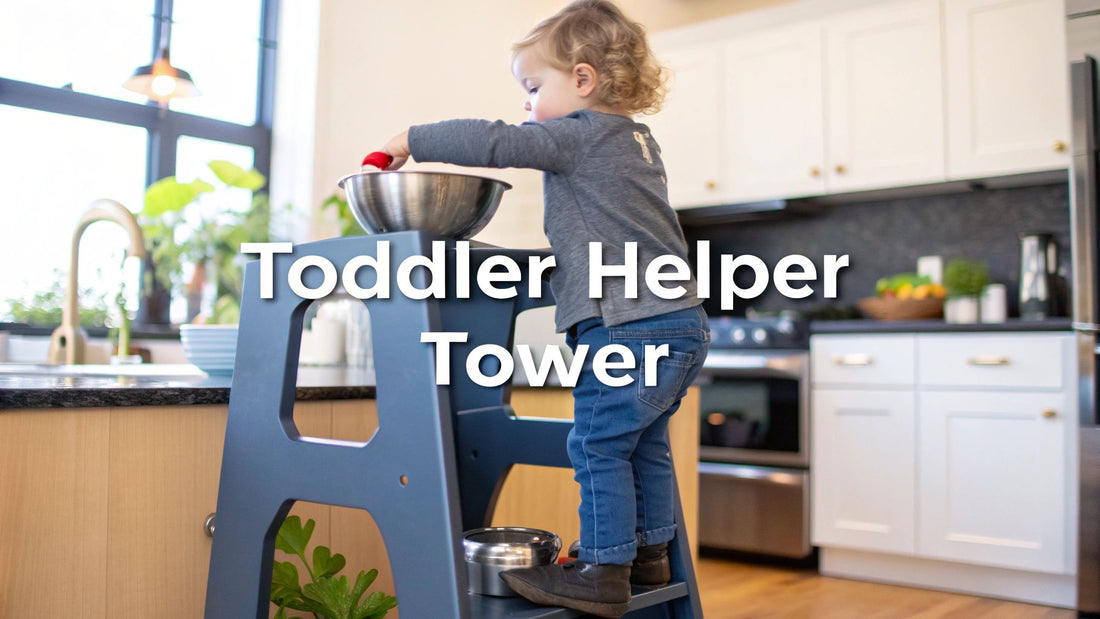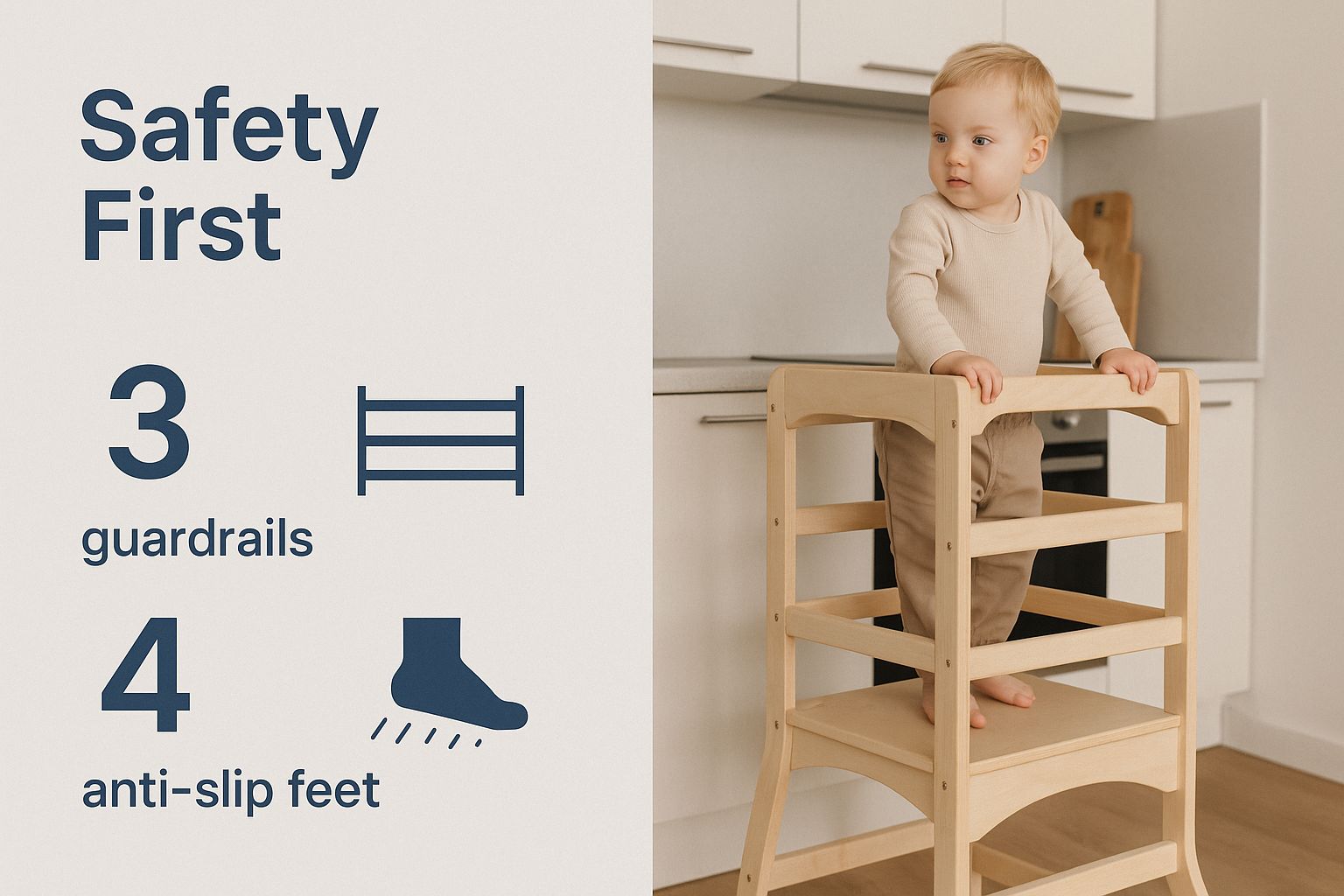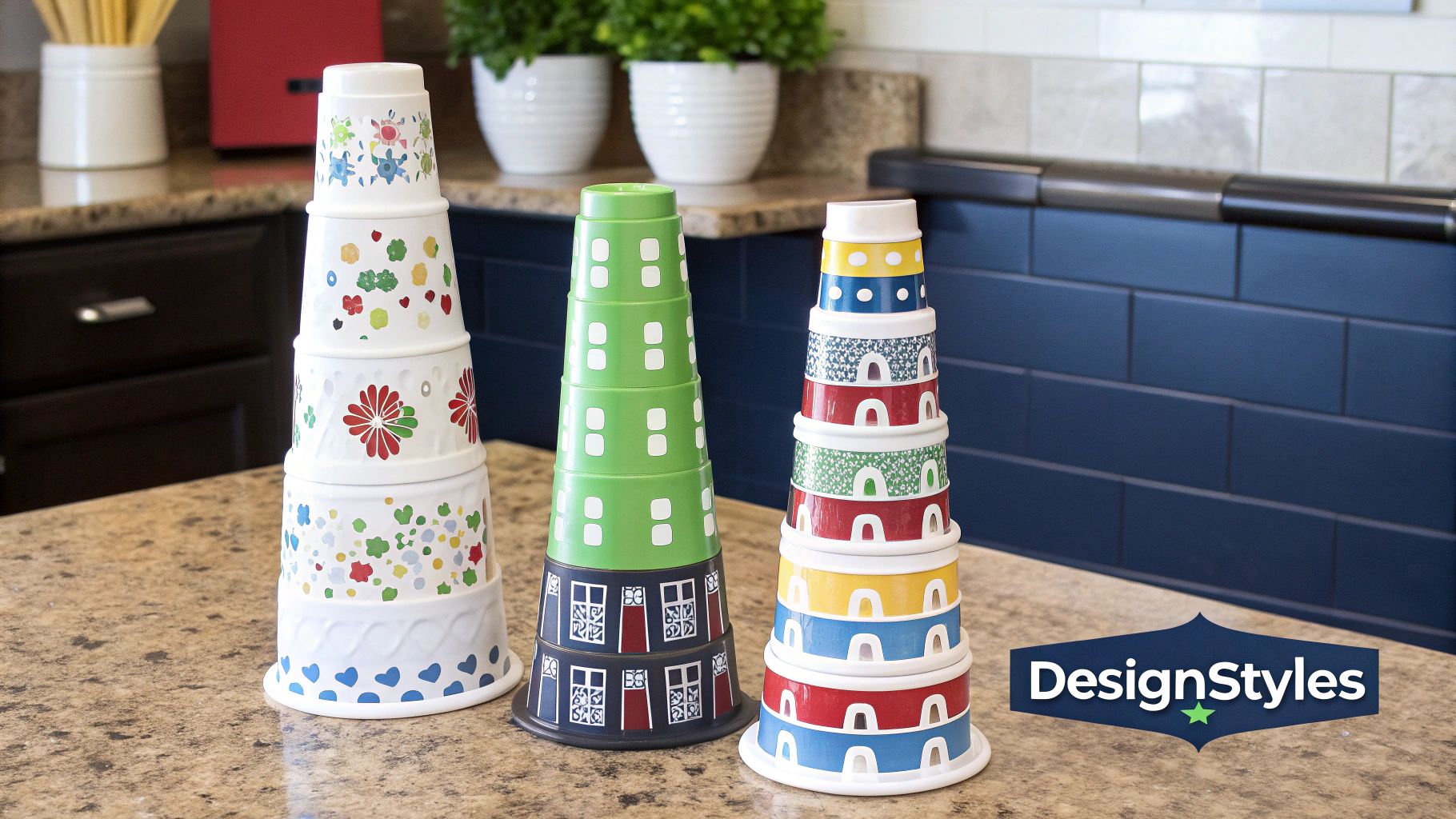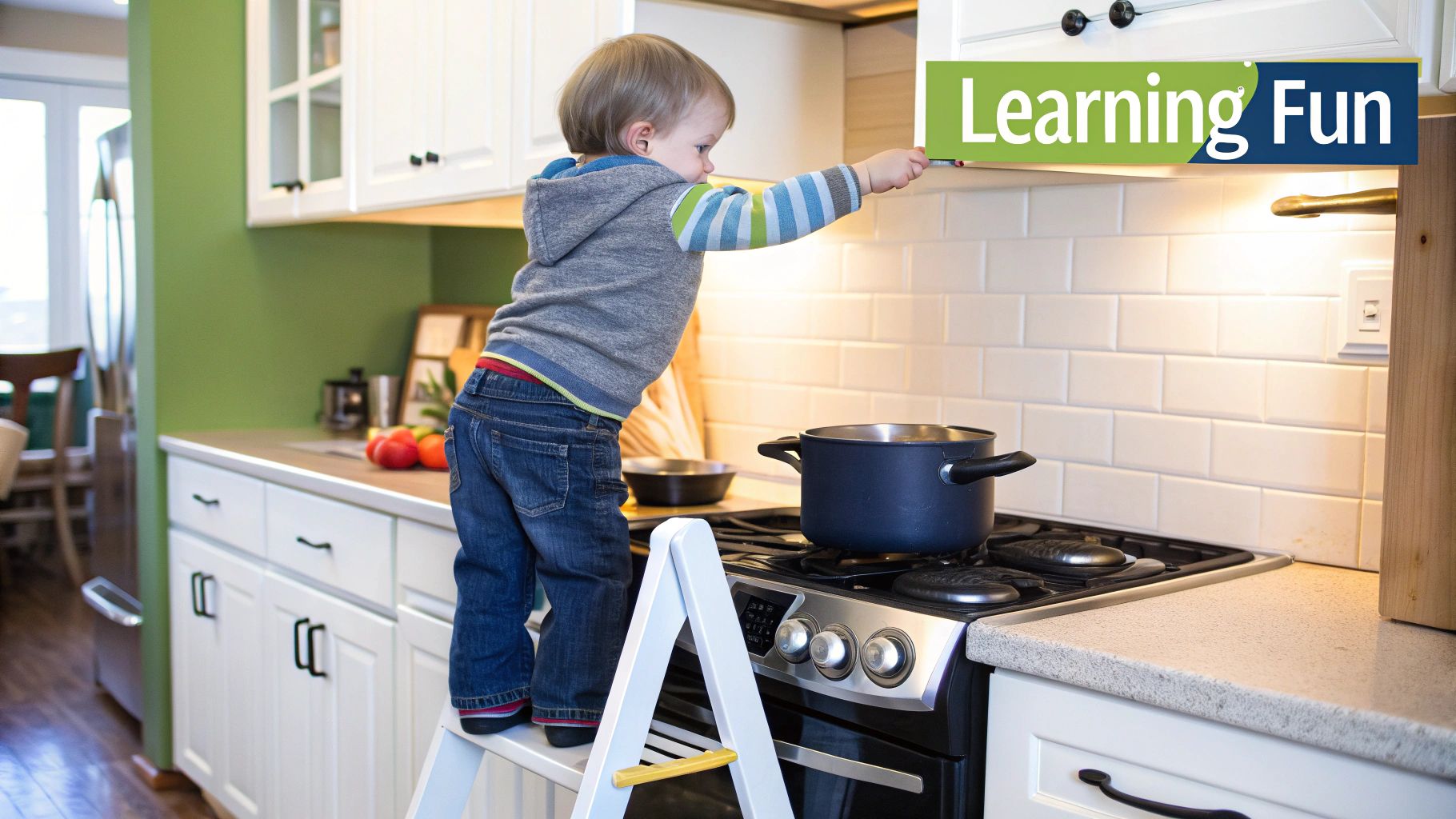
Top Toddler Helper Tower Guide: Safe & Fun Learning
Share
Ever found yourself trying to cook dinner with a toddler clinging to your leg, desperate to see what's happening up on the counter? It’s a classic parenting balancing act—one part cooking, one part toddler-wrangling. This is exactly where a toddler helper tower comes in.
Think of it as more than just a step stool. It's a safe, enclosed platform designed to bring your child right up to counter height, securely. It’s their own personal lift, giving them a front-row seat to the world you operate in every day.
Beyond a Stool: Unlocking Your Toddler's Potential
So, what makes a helper tower different from a regular stool? Safety, plain and simple. A simple step stool can be wobbly and leaves your child at risk of tipping over backwards or sideways. We've all seen that heart-stopping wobble.
A well-designed helper tower, on the other hand, wraps them in a four-sided safety rail. This little enclosure is a game-changer. It frees up their hands to touch, feel, and explore without you having to worry about them losing their balance. This simple design shift is what turns them from a passive observer into an active, hands-on participant.
Fostering Independence and Key Skills
Helper towers are a cornerstone of Montessori-style learning, which is all about empowering kids with practical life skills. By bringing them up to your level, you’re opening up a world of possibilities for them to get involved.
- Practical Life Skills: Suddenly, they can help wash veggies for dinner, stir the pancake batter (with a little help!), or place napkins on the table. These small tasks are huge for developing their fine motor skills and coordination.
- Confidence Building: The look on a toddler's face when they successfully mash a banana for bread is priceless. Accomplishing these "big kid" tasks gives their self-worth an incredible boost.
- Cognitive Growth: Helping in the kitchen sneakily introduces them to early learning concepts. They’re exposed to counting (two scoops of flour), measuring, and following a sequence—the building blocks for math and science.
The real magic of a toddler helper tower isn't just about reaching the counter; it's about closing the gap between "watching" and "doing." It invites your child into your world, transforming daily chores into shared moments of connection and learning.
Before we dive deeper, let's quickly summarize how these towers contribute to your child's growth.
Key Benefits of a Toddler Helper Tower at a Glance
This table breaks down the core advantages of using a helper tower, showing how everyday activities support crucial developmental milestones.
| Benefit | Developmental Impact | Example Activity |
|---|---|---|
| Promotes Independence | Builds self-confidence and a sense of capability. | Pouring pre-measured ingredients into a bowl. |
| Enhances Fine Motor Skills | Develops hand-eye coordination and dexterity. | Stirring batter, washing fruits, or kneading dough. |
| Encourages Cognitive Growth | Introduces early math, science, and sequencing. | Counting eggs, watching ingredients change, following a recipe. |
| Strengthens Family Bonds | Creates opportunities for connection and teamwork. | Cooking a meal or washing dishes together side-by-side. |
| Improves Language Skills | Fosters communication through shared activities. | Naming ingredients, describing textures, and talking through steps. |
As you can see, a simple piece of furniture can have a profound impact on your little one's development, turning routine tasks into rich learning experiences.
The Emotional and Social Benefits
Beyond the tangible skills, the time spent together in the helper tower is pure gold for your relationship. Cooking side-by-side or washing hands at the "big sink" creates natural, unforced moments for conversation and connection.
It shifts the dynamic entirely. Instead of feeling left out down on the floor, your child feels like a valued, contributing member of the family team. This sense of belonging is huge for their emotional development. They learn that they are capable and that their help matters, nurturing a positive attitude toward household tasks that can last a lifetime.
Understanding Essential Safety Features
When you bring a toddler helper tower into your home, you're doing more than just adding a new piece of furniture. You're investing in a safe space for your little one to explore, learn, and be part of the action. But not all towers are built the same, and really getting a handle on the why behind each safety feature is what gives you true peace of mind.
Think of it like buying a car seat. You wouldn’t just grab one off the shelf because you like the color, right? You’d dig into its safety ratings and design. The same critical eye is needed here.
The core of any secure tower is, quite literally, its foundation. A wide, stable base is your number one defense against tipping. We all know toddlers are little bundles of unpredictable energy—they lean, they reach, they wiggle. A tower with a broader footprint is like a sturdy tree with deep roots; it stands firm when your child makes a sudden lunge for that shiny spoon just out of reach.
Next up, non-slip surfaces are completely non-negotiable. This is crucial in two places: the platform where your little one stands and the feet of the tower itself. Grippy feet keep the whole thing from sliding around on a slick kitchen floor, while a non-slip platform makes sure your toddler’s feet stay put, even if there’s a small spill.
This image really drives home the most critical safety elements to keep an eye out for.

As you can see, features like sturdy guardrails and those anti-slip feet all work in concert to create a secure little world for your helper.
Beyond the Base and Guardrails
While a solid frame is the starting point, the small details are just as important. Four-sided safety railings are an absolute must. They create a protective little cocoon that lets your child focus on stirring or washing without the risk of accidentally stepping backward or sideways off the platform—a common danger with wobbly old step stools.
It's also so important to check the manufacturer's guidelines for age, weight, and height limits. These aren't just suggestions; they are carefully calculated limits to ensure the tower holds up safely. Pushing these boundaries can turn a helpful tool into a serious risk.
One of the most overlooked safety aspects is the presence of small gaps and openings. A thoughtfully designed tower will be free of any entrapment hazards, meaning no spaces where a child’s head, arms, or tiny fingers could get stuck.
Here’s a shocking fact: there are currently no federal safety standards specifically for toddler towers in the U.S. A Consumer Reports evaluation of 16 popular models found that only three passed their tough tip-over and entrapment tests. This really highlights how much parents need to be vigilant. In one test, a simulated 35-pound toddler climbing the side caused most towers to tip right over, showing just how easily an accident can happen with a poorly designed product.
Making an Informed Choice
At the end of the day, picking the right tower comes down to a hands-on evaluation. When you’re shopping around, pay close attention to these key points:
- Material Quality: Does the wood feel solid and smooth, free of splinters? Are any plastic parts thick and durable?
- Construction: Check the joints and screws. Are they tight and secure? Flimsy construction is a huge red flag.
- Entrapment Risks: Run your hands along the tower and look for any openings that could pose a hazard for little limbs.
By carefully looking over these features, you can confidently choose a toddler helper tower for the kitchen that provides a truly secure platform for countless fun moments together.
Comparing Materials and Design Styles
When you're picking out a toddler helper tower, it's about more than just finding a color that matches your kitchen. The materials and the design itself are huge factors in how safe, durable, and practical it will be for your family. Think of it like choosing a car: you wouldn't take a tiny city car on a rugged off-road trail, right? The same logic applies here—the tower needs to fit your family's journey.

Let's start with the foundation: the material. This is what gives the tower its strength and determines how long it will last.
- Solid Wood (Birch, Pine): This is a classic choice for a reason. It's sturdy and looks great. Birch is especially tough and holds up well to wear and tear, making it a premium pick for a tower you want to last for years.
- Plywood: Don't underestimate high-quality plywood. It's engineered for stability, often more budget-friendly than solid wood, and can definitely handle the chaos of daily toddler life.
- Plastic: While you won't see them as often, plastic towers have their perks. They're super lightweight and an absolute breeze to wipe clean. If easy maintenance and portability are at the top of your list, this is a practical option.
Just picture your kitchen for a moment. If it’s the heart of the home where spills are a daily occurrence, a tower with a smooth, sealed wood finish or a plastic one will be your best friend.
Finding the Right Design for Your Space
Beyond the materials, the actual design of the tower dictates how it will function in your home. The right one will blend right in, while the wrong one can feel like a bulky obstacle you're constantly tripping over.
Stationary Towers are the tried-and-true workhorses. They’re built with a fixed frame for maximum stability, which makes them a fantastic choice if you have a spacious kitchen where the tower can have its own permanent spot. Their solid build often gives parents the most peace of mind.
Foldable Towers are a lifesaver for smaller spaces. If you live in an apartment, have a cozy kitchen, or want a tower you can tuck away at the grandparents' house, this is your go-to. They collapse down for easy storage in a closet or pantry. Just make sure the locking mechanisms are solid so it doesn't accidentally fold up during use!
Convertible Towers are the multitaskers of the group. These clever designs transform from a tower into a little table and chair set. This means the tower’s usefulness extends far beyond the toddler years, giving your child a spot for snacks, crafts, and playtime.
A convertible tower is a smart investment in long-term usability. It adapts as your child's needs evolve, shifting from a kitchen assistant to a creative workstation, maximizing its value over several years.
A perfect example is the Piccalio Mini Chef Convertible Helper Tower. It switches between a tower and a child-sized table, making it perfect for everything from coloring to enjoying a snack. Built from a combination of birch and pine, it has special locks to keep it secure in both modes. A little tip: be careful not to overtighten the screws during assembly to avoid cracking the wood. You can find more insights about adaptable toddler towers and see how they can be a great fit for families looking for furniture that truly grows with their child.
How to Choose the Right Tower for Your Home
Picking out the perfect toddler helper tower can feel like a huge decision, but it gets a lot easier when you know what to look for. Don't think of it as just another piece of furniture to buy. Instead, think of it as finding the right tool that fits your family's unique rhythm. The right tower will slide right into your daily life, while the wrong one can end up being a clunky obstacle you’re always tripping over.
First things first, take a look at your space. Do you have a big, open kitchen where a sturdy, stationary tower can live permanently? Or is your kitchen on the cozier side, where every inch of floor space is precious? For smaller apartments, a foldable tower can be an absolute lifesaver, letting you tuck it away and get your space back when you're done.
Of course, your budget is a big piece of the puzzle. You’ll find everything from simple plastic models to gorgeous, premium solid wood designs. It’s tempting to just grab the cheapest option, but try to think about the long game. Putting a little more into a durable, adjustable tower now can mean it lasts through several years and grows right alongside your child.
Key Questions to Ask Yourself
Before you hit "buy," take a minute to run through this quick mental checklist. Answering these will help you filter through all the options and land on the one that’s just right for your home.
- How old is my child? This is a big one. For younger toddlers, say around 18 months, an adjustable platform is a must-have. You want the safety rail to hit them around their midsection, not up by their chin. For a deep dive, check out our guide on finding the perfect tower height for little helpers to make sure you get a safe and secure fit.
- What will we actually use it for? Is this purely for kitchen adventures, or are you picturing a multi-purpose station for all sorts of activities? Some models are brilliantly designed to convert into a little desk and chair, giving you incredible value for crafts, snacks, and playtime.
- How many little helpers will be using it? If you have twins or two kids very close in age, a double-wide tower can be a real peacemaker, stopping those "it's my turn!" squabbles before they even start.
The real goal here is to find a tower that fits your child's current stage but has the flexibility to grow with them. Honestly, an adjustable platform is the single most important feature for both safety and getting years of use out of it.
Special Considerations for Your Family
Every family is different, and thankfully, tower designs have evolved to match. If you have twins, for example, a wider model like the RAD Children’s Furniture Toddler Tower offers a double-sized option with adjustable height. For those of us in tight quarters, a foldable design like the Double Helper Tower gives two kids plenty of room but stores away easily.
Taking a moment to think through your space, your budget, and how you'll really use it will make all the difference. You’ll be able to choose a tower with confidence, knowing it will become a well-loved—and super functional—part of your home.
Assembly and Long-Term Maintenance Tips
Bringing a new toddler helper tower into your home is such a great moment. But getting it set up right—and keeping it that way—is just as important as picking the perfect one. Proper assembly and a little bit of upkeep are what will make your tower a safe, sturdy part of your family’s daily life for years to come.

When the box arrives, I know it’s tempting to dive right in and start building. But take a beat. Lay out all the pieces and check them against the parts list in the manual. This one simple step can save you a headache later by making sure everything you need is right there from the start.
As you put it together, you’ll want to tighten the screws so they’re nice and snug, but don't go overboard. It's especially important with wooden towers because too much force can actually crack the wood and weaken the whole structure. The sweet spot is a solid, stable build without straining any of the materials.
Creating a Maintenance Routine
Once your tower is built, it needs a little TLC to stay in great shape. Think of it as a quick tune-up. A simple, regular check-in can catch tiny issues before they turn into bigger problems. Making this a monthly habit is a fantastic idea.
Here’s a quick checklist you can run through for your routine safety scan:
- Check for Loose Screws: Give the railings and legs a little wiggle. Feel anything wobbly? Go ahead and tighten any hardware that’s loosened up from all that happy toddler movement.
- Inspect for Wear and Tear: Run your hands over the wood to feel for any splinters or new cracks. If you have a plastic model, look for any stress marks or little breaks.
- Confirm Platform Stability: Make sure the standing platform is still locked securely in place. This is especially key for adjustable models where the platform can be moved.
Your tower is used daily by an active, growing child. Regular inspections aren’t just about upkeep; they are an active part of maintaining a safe environment where your little one can thrive and learn.
Finally, keeping the tower clean is a must for good hygiene. For specific advice based on your tower’s material, our guide on cleaning toddler towers and ensuring they stay upright has some great, practical tips. By weaving these simple assembly and maintenance habits into your routine, you’ll ensure the tower remains a safe and cherished tool for countless kitchen adventures.
Got Questions About Toddler Helper Towers? We've Got Answers.
Thinking about bringing a helper tower into your home? You’ve probably got a few questions. It’s a pretty big piece of gear, and you want to be sure you're making the right call. We hear a lot of the same questions from parents, so we’ve put together some straight-up answers to help you feel confident and ready.
We’ll get into everything from the right age to start, to safety, to what daily life with a tower actually looks like. The idea is to clear up any confusion and show you how a tower can fit right into your family's routine, safely and easily.
At What Age Can My Toddler Use a Helper Tower?
This is the big one—when is the right time to start? Most brands will tell you around 18 months, but honestly, it’s less about their age and more about their physical ability.
The real green light is when your little one can stand, totally unassisted and stable, without wobbling or needing to grab onto something. Once they’ve mastered that, they’re ready. When you first set up the toddler helper tower, pop the platform on the highest setting. This puts the safety rail right around their chest level, which is exactly where you want it for maximum security.
Just think of the first couple of weeks as a learning curve for both of you. Stick close by and supervise them as they figure out how to climb in and out. That little bit of hands-on guidance at the beginning will build their confidence and set them up for years of safe helping.
Is a Helper Tower Safer Than a Step Stool?
Without a doubt, yes. And it all comes down to the design. A simple step stool is fine for a 30-second task like a quick hand wash, but anything longer than that? You're entering the danger zone. A stool leaves a toddler vulnerable to tipping over, especially backwards or sideways.
A toddler helper tower’s four-sided enclosure is the game-changer. It creates a little safe zone where your child can put all their focus on what they're doing—stirring batter, squishing play-doh, or just watching you cook.
That enclosed design is what makes all the difference. It takes your child from a wobbly balancing act to a secure, protected little helper, which gives you some much-needed peace of mind.
That barrier lets them use both hands without having to think about staying upright. It’s this one feature that makes it a much, much safer choice for any activity that keeps them at the counter for more than a minute.
How Can I Teach My Toddler to Use the Tower Safely?
The key to safe use is setting clear, simple ground rules from day one. It helps to present the tower as a special tool for helping, not just another piece of climbing furniture. Keep the rules simple and easy for a toddler to remember.
These basics are a great place to start:
- Feet Stay on the Platform: We always keep our feet flat on the floor of the tower.
- No Leaning Over the Side: Our bodies stay inside the "magic box."
- One Helper at a Time: It's a one-person job, unless you have a tower built for two!
Of course, active supervision is a must, especially in the kitchen where you’ve got hot stoves, knives, and other hazards. A great tip is to always have an activity ready to go before they climb in. It keeps them engaged and less likely to start testing the boundaries.
Finally, show them how to get out safely. Teach them to turn around and climb down backward, feet-first, just like going down a ladder. It's a lot more stable than trying to step out forwards. With a little consistency and a watchful eye, the tower will become a safe and happy part of your daily routine.
Ready to create a safe and engaging space for your little one to learn and grow alongside you? The Ocodile standing tower is designed with your child’s safety and your peace of mind at its core. Discover the perfect blend of style, functionality, and security by exploring our collection today at https://ocodile.com.









